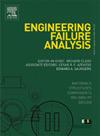Dynamic identification and collapse mechanisms of unreinforced masonry Heritage: A comprehensive study of Erzurum Atatürk House
IF 5.7
2区 工程技术
Q1 ENGINEERING, MECHANICAL
引用次数: 0
Abstract
This study presents a comprehensive seismic assessment of the historical Erzurum Atatürk House, a representative example of unreinforced masonry (URM) structures in Turkey’s high-seismicity region. The research combines experimental and numerical approaches, including operational modal analysis (OMA), detailed finite element modeling, and nonlinear dynamic analyses using nine recorded ground motions. The OMA identified the structure’s first three natural frequencies at 3.458 Hz (N-S translation), 3.984 Hz (E-W translation), and 4.264 Hz (torsional mode), with MAC values exceeding 0.9, confirming the accuracy of the calibrated numerical model. Nonlinear time-history analyses revealed critical vulnerabilities, with peak displacements exceeding acceptable limits for all considered seismic scenarios (including 2023 Kahramanmaraş earthquakes). The structure exhibited brittle failure mechanisms characterized by Rapid stiffness degradation; Significant tensile cracking at wall-floor junctions; Out-of-plane failures in upper-story walls; Diagonal shear band formations. Material characterization showed low tensile (0.3–1.07 MPa) and compressive (3–10.71 MPa) strengths, typical of historical masonry with weak lime-based mortars. The force–displacement relationships demonstrated limited energy dissipation capacity, with strength degradation occurring at approximately 10,000 kN lateral load. These findings provide fundamental insights into the seismic behavior of historical URM buildings and establish a methodological framework for their assessment. The study highlights the critical need for further research on performance-based evaluation methods for cultural heritage structures in seismic zones.
无加固砌体遗产的动力识别与倒塌机制——Erzurum atatrk住宅综合研究
本研究对历史上的Erzurum atatrk住宅进行了全面的地震评估,这是土耳其高地震活动区无加固砌体(URM)结构的代表性例子。该研究结合了实验和数值方法,包括运行模态分析(OMA)、详细的有限元建模和使用9个记录的地面运动的非线性动力学分析。OMA确定了该结构的前三个固有频率为3.458 Hz (N-S平移),3.984 Hz (E-W平移)和4.264 Hz(扭转模式),MAC值超过0.9,证实了校准数值模型的准确性。非线性时程分析揭示了关键的脆弱性,所有考虑的地震情景(包括2023年kahramanmaraku地震)的峰值位移都超过了可接受的限制。结构表现出以刚度快速退化为特征的脆性破坏机制;墙体-楼板连接处有明显的拉伸开裂;上层墙体面外破坏;斜向剪切带地层。材料性能表现为抗拉强度(0.3-1.07 MPa)和抗压强度(3-10.71 MPa)较低,是典型的历史弱石灰基砂浆砌体。力-位移关系表现出有限的能量耗散能力,在大约10,000 kN的侧向荷载下发生强度退化。这些发现为历史URM建筑的地震行为提供了基本的见解,并为其评估建立了方法框架。该研究强调了进一步研究基于性能的震区文化遗产结构评估方法的迫切需要。
本文章由计算机程序翻译,如有差异,请以英文原文为准。
求助全文
约1分钟内获得全文
求助全文
来源期刊

Engineering Failure Analysis
工程技术-材料科学:表征与测试
CiteScore
7.70
自引率
20.00%
发文量
956
审稿时长
47 days
期刊介绍:
Engineering Failure Analysis publishes research papers describing the analysis of engineering failures and related studies.
Papers relating to the structure, properties and behaviour of engineering materials are encouraged, particularly those which also involve the detailed application of materials parameters to problems in engineering structures, components and design. In addition to the area of materials engineering, the interacting fields of mechanical, manufacturing, aeronautical, civil, chemical, corrosion and design engineering are considered relevant. Activity should be directed at analysing engineering failures and carrying out research to help reduce the incidences of failures and to extend the operating horizons of engineering materials.
Emphasis is placed on the mechanical properties of materials and their behaviour when influenced by structure, process and environment. Metallic, polymeric, ceramic and natural materials are all included and the application of these materials to real engineering situations should be emphasised. The use of a case-study based approach is also encouraged.
Engineering Failure Analysis provides essential reference material and critical feedback into the design process thereby contributing to the prevention of engineering failures in the future. All submissions will be subject to peer review from leading experts in the field.
 求助内容:
求助内容: 应助结果提醒方式:
应助结果提醒方式:


